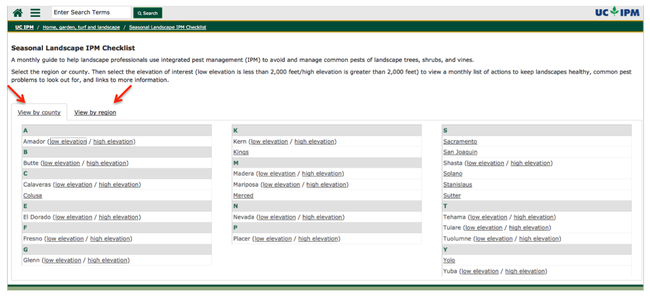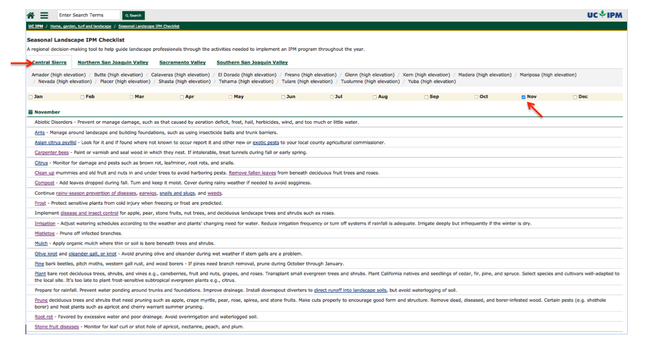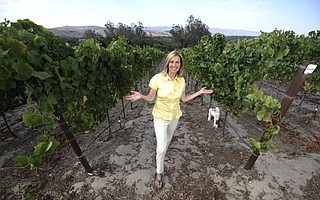UC Food and Agriculture Blogs
New Seasonal Checklist to Help Combat Landscape Pests
UC IPM has a brand new resource called the Seasonal Landscape IPM Checklist (or SLIC). The checklist is a regional decision-making tool designed to help guide landscape professionals and home gardeners through a yearly list of activities to prevent,...

Screen Shot 1

Screen Shot 2
Have a Happy Thanksgiving without unzipping
- Portion control: Thanksgiving is about choices. Think about which dishes you don't mind skipping, and plan to fill your plate only once. It's easy to get carried away going back for second and third helpings.
- Fruits: Get your serving of fruit with a fruit-based dessert. Baked apples, poached pears and fresh figs are a few festive options.
- Grains: Use whole grain or 100 percent whole wheat bread for a stuffing rich in fiber.
- Protein: Serve yourself 3 ounces of roasted turkey or a portion the size of your palm. Skip the fat by removing the skin on your turkey before eating it. Go easy on the gravy.
- Vegetables: Choose vegetable side dishes that include roasted or cooked vegetables, and skip the creamy sauces and added fat. Instead, season vegetables with fresh herbs to add flavor.
- Dairy: Try non-fat Greek yogurt as a healthier topping for side dishes than sour cream or butter.
- Don't forget to be active. After the holiday meal, go for a walk, bike ride or play football with the family.
Not sure what to do with your leftovers? Reinvent your Thanksgiving feast with these quick and easy one-sentence leftover recipes.
- Cranberry smoothies
Whirl cranberries with frozen low-fat yogurt and orange juice. - Crunchy turkey salad
Toss cubed turkey with celery, apples, and light mayo with shredded spinach. - Stuffing frittata
Mix stuffing with egg and cook thoroughly, pancake-style. - Turkey berry wrap
Wrap sliced turkey, spread with cranberry sauce and shredded greens in a whole wheat tortilla.
Recipe source: www.eatright.org
Author: Melissa Tamargo
Nightly Neighborhood Nuisance
It's not uncommon to see opossums running through your backyard or neighborhood. Opossums are small, house cat-sized animals that have coarse, grayish fur, a pointed face and round, hairless ears and a long, hairless tail. Their feet resemble small hands...
UC Small Farm Advisor works with grower to push the "Horticultural Envelope"
This article by Matt Kettman was published in the Santa Barbara Independent on October 6, 2015. UC Small Farm Advisor, Mark Gaskell, has been providing technical assistance to small-scale growers in Santa Barbara and San Luis Obispo counties for more than 20 years. Sandra Newman has established certified organic blueberries, gooseberries, mulberries, and other specialty crops on her 100 acres of sandy soil and been growing and marketing them successfully for more than a dozen years.
Blueberries, Pinot Noir, Mulberries, and More Thrive at Sandra Newman's Forbidden Fruit Farms Near Lompoc
Story by Matt Kettmann
The advisor, however, asked whether she had money and time to burn. As a widow approaching retirement age, lacking a fortune, and still paying bills through her Orange County–based digital SEC filing service, Newman had neither luxury. “I have a budget,” Newman told me during a visit this past summer to the property. “My daddy didn't buy it for me; my husband didn't buy it for me. I'm probably the only one out here who still has a mortgage.”
So the advisor suggested planting blueberries, which, if they ripened anytime other than when the blueberry market is typically flooded, would deliver nearly instant returns. In went two acres of the shrubs — they ripened exactly at the right times — and Forbidden Fruit Orchards was born. Newman was soon selling her organically grown blueberries to upscale grocers and through farmers' markets from San Francisco to Los Angeles, using the proceeds to grow her property from a few abandoned apple trees into a dynamic estate with multiple buildings.
And she kept planting, from more blueberries (now 8.5 acres) to Pakistani mulberries, avocados, apples, red and pink currants, figs, bananas, gooseberries, and more. Among the more interesting choices are the hardy kiwis (smaller than usual and hairless so that you eat the whole thing, but she's still getting them to flower at the right time), green tea (an experimental project in conjunction with the University of California), and hops for beer, which are tended to by Brian DeBolt and Casey Birthisel of Pacific Valley Hops. Many of these items will be integrated into the menu of the upcoming farm-to-table, four-course dinner at the property on November 7, when Chef Sally Ruhl will unveil many of the ingredients she's posting to Twitter under her handle @SallyRuhl.
With the blueberry cash flow, Newman finally did plant wine grapes in 2007, today amounting to 7.5 combined acres of pinot noir and chardonnay. Some grapes are sold to other vintners, but she makes about 600 or so cases in her souped-up garage under the brand Cebada, named after the canyon. The wines are very light and elegant in a deliberately Old World style; the chard is tight and racy, the pinot requires a bit of bottle age to truly shine (so 2011 is great now), and the 2014 rosé is one of the best pinks I've tried of the vintage. Plenty of others think so, too, as it's rare for me to hear so many wine lovers I know rave about the same brand without any prompting.
You can taste them with an appointment at the farm, or just head to Isabella Gourmet Foods on Figueroa Street in downtown Santa Barbara, where Cebada wines are poured upstairs and Newman's jams, teas, and other products are also sold. To get the most bang out of your $10, try them during Thursday and Friday's Classy Hour, when sips come with small food pairings from 4-6 p.m.
Newman also makes a blueberry wine, further evidence that those tiny berries remain the core strength of Forbidden Fruit Orchards. She's currently tending to bidding wars over the recent harvest, since her bushes reach their prime when the market is most desperate. “We hit a really nice window,” she said, “because Chile is not in and the northern hemisphere is done.”
It's certainly not a stress-free existence, and with so many fruits in the air, Newman admits that “sometimes you just have crazy days.” But she's happy with her 100 acres of sand and the evolving cornucopia of trees, vines, and shrubs. “I just love farming,” said Newman. “I love being able to grow and pick the fruit. It's just a passion.”
CEUs Available from UC IPM online
Are you looking for continuing education units (CEUs) to complete your renewal application this year for the Department of Pesticide Regulation (DPR)? The UC Statewide IPM Program has several online courses available that can help you get those...




